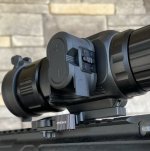Bering Optics is soon to release a new option to their Super Yoter line up. The 25mm Super Yoter will be the newest member along with the incredibly popular 35mm and 50mm versions. I have been testing a prototype of this scope for a few months. The scope features are the same and the only difference besides the lens size is the lens cap. With the very generous 18° FOV, Night Goggles believes many people may be buying this for a scanner as well as a scope. Due to this, we are offering it with either the standard Bering QD mount ($3,495) or with the LaRue QD mount ($3,695). You read that correctly, a Bering Optics Super Yoter with a 12µm, 640 resolution sensor, assembled and serviced in the US, with a 4-year transferrable warranty, 8 reticles, 4 reticle and background color options, internal video recording, WiFi, and more for $3,495.
Product Page
Product Page
Last edited:


